The leaves of the Phalaenopsis orchid turn yellow: why and what to do?
Since the first description of the orchid as a species, it has become an incredibly popular decoration for botanical gardens, greenhouses and home flower gardens. With external fragility and tenderness, orchids are quite hardy, and thanks to breeding research, it was possible to develop new varieties adapted to our conditions and grow orchids at home has become easier.
Content:
- Features of the structure of the Phalaenopsis orchid
- Leaves turn yellow - reasons: improper care
- How to properly care for a plant?
- Leaves turn yellow - causes: diseases
- What to do, how to cure an orchid?
- Leaves turn yellow - reasons: pests
- What to do, how to save a flower?
Features of the structure of the Phalaenopsis orchid
Household orchids are epiphytes - plants with an open root system covered with velamen. Through a porous layer, orchids absorb moisture from the environment and soil, in nature they grow on trees or rocky gorges.
Modern, "domesticated" types can be divided into groups according to the complexity of care:
- For beginner florists. These are the most adapted plants: Dendrobium, Phalaenopsis, Epidendrum.
- For advanced gardeners. These are: Brassia, Celogin, Dendrobium.
- For professional orchid breeders Cattleya, Miltonia and others.
According to the type of growth, orchids are sympodial and monopodial. Sympodial plants have horizontally growing shoots united in a rhizome. Peduncles emerge from the shoots, mainly one or two (depending on the species of the orchid).
In some sympodial plants, shoots appear with leaves from which peduncles emerge.
At the base of the shoots there are thickenings - bulbs, which serve to accumulate water, nutrients for future shoots. But the structure of the bulbs differs from the classic flower bulbs, so it would be more correct to call them "pseudobulbs".
The monopodial type includes ascocenda, vanda and phalnopsis orchids. The plant develops from one main shoot, with alternate growth of leaves. Phalaenopsis have thick shoots, similar to bamboo, and they also serve for the reserve accumulation of moisture and nutrients.
Leaves turn yellow - reasons: improper care
Stressful conditions affect the appearance of the plant - the leaves turn yellow, fall off, become stained, and the flower itself withers. Negative changes are noted with a sharp change in the microclimate, low humidity, abundant watering, injury to the rhizome or damage by pests.
The yellowing of the lower leaves can be justified by aging processes. Leaf death occurs within 2-3 months and affects only the lower tiers. Complete yellowing and seasonal leaf fall is noted only in dendrobium orchids.
Causes of yellowing of leaves in an orchid:
- Natural aging of the leaf. Yellowing of one or two lower leaves with normal color is characteristic of Phalaenopsis and Pafiopedilum orchids.
- Disadvantage lighting... Phalaenopsis orchid belongs to the light-loving species.With a lack of light, the plant can grow for 1-2 years, after which it begins to wilt.
- Yellowing of leaves after sunburn. If the flower stood on the south or west side in sunny weather, then yellowed areas appear on the leaves. It is enough to move the orchid to a less illuminated place, where the burnt leaf or part of it will dry out.
- Insufficient watering of the orchid. With a lack of moisture, the leaves of the flower wrinkle and fall off, but before taking up watering, the condition of the roots is assessed - not always the reason for the wilting of the leaves in the dried substrate. Normally, the color of the roots is light green, with a slight pearlescent tint, a change in color indicates diseases - they can be caused by harmful insects or fungal infections, rot. If a week after watering the condition of the orchid has not improved, it is recommended to re-examine root system.
- Rare but abundant watering. The substrate should not be overdried or flooded with water. Waterlogging of the roots leads to the development of diseases and yellowing of the leaves, and wilting. Signs of excess moisture in the pot: not only the color of the lower leaves changes; to the touch, the leaf becomes less dense, dampish, which indicates rotting; the appearance of dark spots on yellowed leaves; darkening of the roots or the appearance of black spots on them; change in the stem of the plant - darkening and the appearance of plaque. Visually, it seems that the plant is not fixed in the ground.
- Accelerating flower growth with fertilizers and stimulants. In greenhouse cultivation of orchids, increased doses of top dressing are used to accelerate flower growth. After a year or two, the flower is depleted: the growth of new leaves stops, and the old ones begin to turn yellow and fall off. When transplanting into a new soil mixture, the situation does not change, but it is possible to restore the flower. The pot with the plant is transferred to a warm and well-lit place, after which, according to the scheme, feeding is carried out every 14 days. For the first feeding, use a highly diluted conventional orchid fertilizer (dilute to 50% concentration). Later, nitrogen fertilizer is used to build up leaves and strengthen.
Orchid roots are sensitive to mineral fertilizers based on potassium, phosphorus - with a high concentration of the solution, the risk of burning the root system of the flower increases. In case of an overdose, the plant is washed well under warm running water; feeding should be repeated no earlier than after a month and a half.
How to properly care for a plant?
To Phalaenopsis orchid pleased with its well-groomed appearance and lush flowering, it is necessary to create comfortable conditions for the flower:
- Place for the pot. A place protected from direct sunlight with light shade is suitable for the plant. This can be a window sill on the western, northeastern or eastern part of the house, or a small table by the window. Phalaenopsis does not belong to light-browed orchids, and with prolonged contact with the sun's rays, light brown or brown burns are formed on the leaves.
- Temperature conditions. If you keep the plant in a shaded place at a temperature of 18-25 C, the duration of flowering increases. The maximum allowable temperature is 35 C, with a prolonged increase in the temperature regime, the density of the leaves decreases, flowering stops. For normal growth, the optimum temperature ranges from 15-25 C.
- Moisture percentage. The comfortable value of air humidity for phalaenopsis is within 30-40%. The increased value with poor ventilation creates conditions for the development of rot on the root system and leaves, and low humidity affects the tone of the orchid and flowering.
- Watering... Watering Phalaenopsis is carried out when the substrate is completely dry, but you cannot keep the orchid in conditions of aggressive aridity. With insufficient moisture, the root system of the plant brightens. Normally, the color of the roots of the orchid is bright green, and droplets of condensation are visible on the walls of the pot (if it is transparent).Watering an orchid is best done by immersing it in water or pouring it over the substrate. It is not advisable to water the leaves - if the water is not of high quality, then spots form on their surface. It is recommended to rinse the leaf surface once a month under running water, and then wipe it.
- Fertilizer. Fertilizing an orchid is most convenient when watering, strictly observing the proportions of the bait. With excessive and frequent feeding, cracks appear on the leaves.
- Bloom. To stimulate flowering, it is recommended to keep Phalaenopsis cool and water less often, it will be enough to spray the substrate from a spray bottle. To extend flowering up to six months, it is enough to adhere to the temperature regime, observe optimal humidity and diffused lighting. At the end of the flowering period, the peduncle is usually pruned.
- Root and leaf care. When the aerial part of the root dies off, it is removed. Healthy lower leaves are cleaned every 20-30 days under running water and wiped.
- Transfer... You do not need to transplant a newly purchased orchid, it is better to do this after flowering. The substratum is replaced every three years, when it cakes and loses some of its nutritional properties. The composition of the soil mixture includes bark; at low humidity, moss is added to the mixture - it absorbs and retains moisture. Before transplanting, the bark is soaked for 2 days in clean water, after which crushed water is added to it. moss... The mixture ready for transplanting can be used throughout the day.
Leaves turn yellow - causes: diseases
Leaves turn yellow when the root system is damaged by bacteria and fungi. In severe cases, the entire plant becomes infected and dies:
- The causative agent of black rot is a fungus late blight... It spreads quickly and is easily transmitted to healthy orchids.
- With root rot, the roots of the plant are affected first, after which the fungal infection covers the tuberidia and leaves. It appears as black, dense spots.
- The causative agents of brown rot are the bacteria Erwinia, Pseudomonas. Young flowers are often affected, if the infection covers the growth point and stems, then the orchid dies. It appears as brown, watery areas.
- Cause anthracnose, rust, fusarium, gray rot - fungus. At first, the leaves turn yellow, then soften and rot with spores.
- Among viral diseases, phalaenopsis is more often affected by cymbidium mosaic, ring virus, cattleya mosaic.
What to do, how to cure an orchid?
To cure an orchid from a viral, bacterial or fungal disease, the cause and sources of infection are clarified. Further treatment tactics are aimed at destroying the diseased plant (if the root, growing point, rhizome is affected) or removing the affected leaves at an early stage of infection.
For infections caused by fungi, treatment is indicated fungicidal preparations: "Fundazol" 0.2%, "Topsin-M" 0.2% and other drugs for a period of at least 10 days. For the purpose of prevention, the treatment is repeated after 30 days.
Leaves turn yellow - reasons: pests
Orchids, like other houseplants, are susceptible to attack by harmful insects. To save a flower, you need to know which insects parasitize orchids:
- Scabbard - manifests itself in the form of growths and tubercles on the leaves, it is difficult to see them with the naked eye. They appear at elevated temperatures in the soil.
- Aphid - deforms leaves and disrupts plant nutrition. Transfers fungal and viral infections.
- Mealybugs look like small lumps of cotton wool, stand out well against the background of the substrate. Leaves and shoots of young plants are affected.
- Spider mite - affects leaves and shoots.
- Thrips - mainly affect leaves, stems and inflorescences. Appear as yellow or brown stripes on the surface.
- Nematodes - a variety of worms that infect shoots, leaves, stems.
- Legstails are small jumping insects that infect the rhizome.
What to do, how to save a flower?
It is much easier to prevent the appearance of harmful insects than to treat the affected plant. It is recommended to check each new plant for insects - for this, the top of the pot is wrapped in polyethylene and the flower is immersed in water. Worms or nematodes can be identified by examining the substrate.
Treatment of orchids from parasites is carried out in two ways:
- Mechanically - the affected parts of the plant are cut or removed.
- Chemically processed and refined flowers are sprayed insecticides: Fitoverm, Aktellik, Tiofos, Neoron. Spraying is carried out twice every 14 days. Treatment is considered successful if not a single pest is found on the flower in a month.
More information can be found in the video:



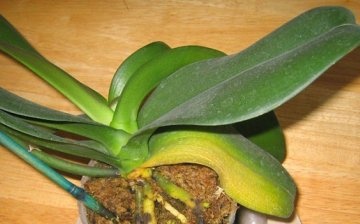
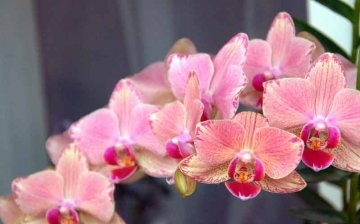
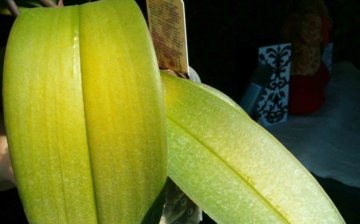

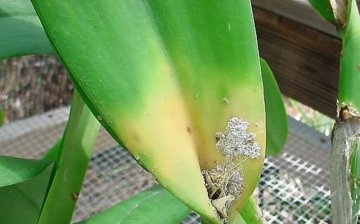







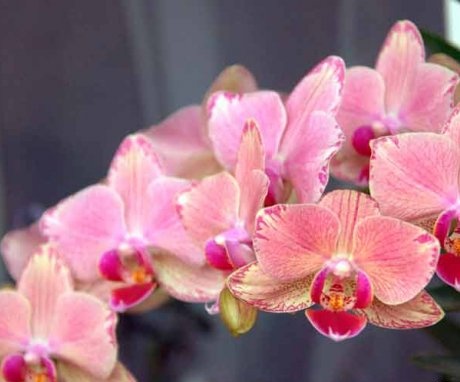
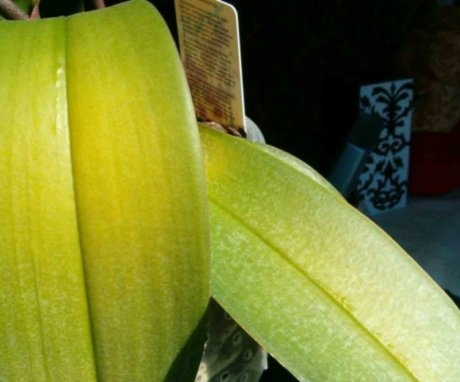
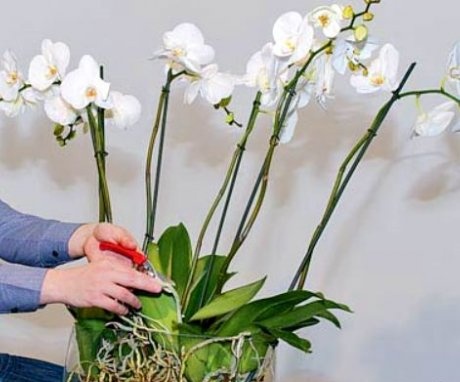
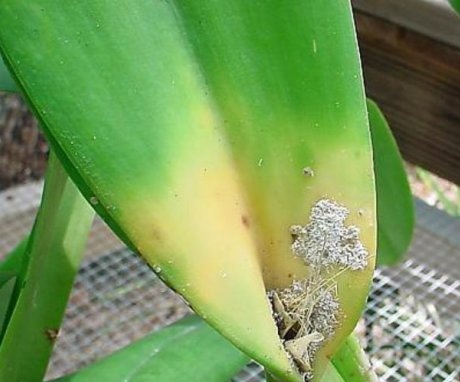
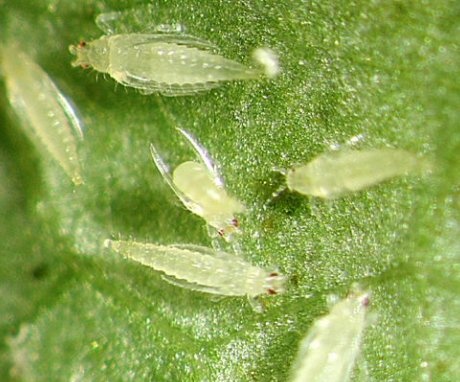
I had the same problem, only the roots were drying out. The flower is very fond of water, in nature it grows in a humid environment. I decided that I changed the bark, more often I began to water and spray abundantly.